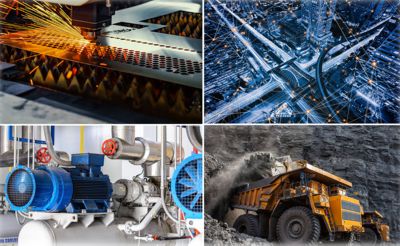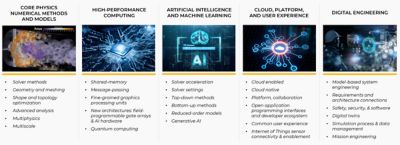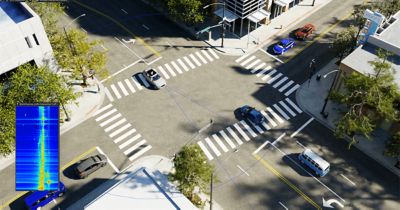-
-
Access Free Student Software
Ansys empowers the next generation of engineers
Students get free access to world-class simulation software.
-
Connect with Ansys Now!
Design your future
Connect with Ansys to explore how simulation can power your next breakthrough.
Countries & Regions
Free Trials
Products & Services
Learn
About
Back
Products & Services
Back
Learn
Ansys empowers the next generation of engineers
Students get free access to world-class simulation software.
Back
About
Design your future
Connect with Ansys to explore how simulation can power your next breakthrough.
Free Trials

Digital engineering is impacting industrial processes and manufacturing in nearly every market, from automotive and aerospace to healthcare and energy. The fourth industrial revolution, known as Industry 4.0, marked the beginning of this digital transformation. Today, the trend continues with the fifth revolution, known as Industry 5.0, which aligns well with digital engineering and simulation’s role in it.
Industry 4.0 focused on technology, but Industry 5.0 concentrates on the human–technology connection. It also emphasizes interaction and collaboration. The European Commission describes Industry 5.0 as more comprehensive than 4.0, highlighting sustainability, human-centricity, and resilience pillars.

Digital engineering supports Industry 5.0 and its pillars in several ways. First, the human–technology connection is a relationship dynamic inherent to digital engineering and simulation workflows. Further, using digital solutions, engineers can create a digital thread throughout all product stages to increase interaction, collaboration, and success.
Ansys’ comprehensive and open ecosystem of multiphysics simulation software spans all areas of physics, from mechanics and fluid dynamics to thermodynamics and electromagnetics. Additional simulation solutions support niche technologies and areas such as digital twins, artificial intelligence/machine learning (AI/ML), and cloud computing. At the same time, Ansys Connect solutions enable digital engineering more easily by linking simulation, data, and resources across an organization into a single thread. These solutions include simulation process and data management, materials management, process integration and design optimization, and model-based systems engineering (MBSE).
As a result, digital engineering — powered by comprehensive simulation solutions — increases operational efficiency throughout the product life cycle from design to retirement, including operations and maintenance (O&M). This helps tackle industry challenges, boost the resilience of industrial processes, cut costs, and support sustainability.
Maximize Simulation for Efficient Engineering
By integrating multiphysics simulation and related simulation methodologies, industrial equipment manufacturers and operators gain critical engineering insights to improve the behavior, performance, durability, and reliability of machinery, equipment, and infrastructure. In addition, virtual testing and prototyping accelerate design and development, which minimizes the time, cost, and material waste related to traditional physical methods.
Further, with advanced sensors, AI/ML integration, and techniques like reduced-order modeling, engineers can create digital twins and leverage physics-based simulation insights well into O&M. Simulation-powered digital twins enable real-time systems analysis, predictive maintenance, and performance optimization. Predictive maintenance and other efficiency-first industrial practices like asset health performance and life cycle optimization are being implemented by plants and other sites to increase the safety, reliability, and operational life of machinery and equipment.
Harnessing the power of simulation, AI/ML, and reduced-order modeling, Ansys digital twin solutions integrate the accuracy of physics models with insights from real-world data. The result is a hybrid digital twin, which produces higher accuracy than a traditional digital twin.
Reduced-order models (ROMs) simplify complex, high-fidelity models and democratize simulation by making insights more understandable and accessible to non-simulation experts. This empowers team members across industrial units, including plant operators on the manufacturing floor.
Similarly, sensors and cyberphysical systems — such as robots, conveyors, and select material processes like coating or mixing — can leverage ROMs and digital twin technology to optimize operations and support real-time operator interaction regarding adjustments to manufacturing equipment. In connection, high-fidelity system models and digital twins create new possibilities for commissioning plants or training new operators virtually.
Get Smart and Overcome Industrial Complexities
As technology advances across industries — especially with the rise of software-defined products ranging from smart watches to smart thermostats — the need for system-level modeling is greater than ever. Sophisticated systems and complex research and development (R&D) have also reached industrial sectors, including smart manufacturing and processing; smart infrastructure; robotics and industrial equipment; and heavy machinery, rail, and commercial marine operations.
Unsurprisingly, smart manufacturing has led to the emergence of smart factories, also known as digital or intelligent factories. Smart factories feature interconnected machines, networks, and technologies such as AI/ML, cloud computing, and Industrial Internet of Things (IIoT) devices like sensors to collect information, accelerate data transfer, and streamline processes, often using automation or robotics.

Industrial sectors rely on technologies like smart manufacturing and processing, smart infrastructure, robotics and industrial equipment, and advances in heavy machinery.
Multiphysics simulation overcomes industrial R&D complexities in several ways. Engineers and designers increasingly support data fusion in a trend to “shift simulation left,” or integrate simulation earlier in the product life cycle. In one respect, multiphysics simulation provides critical engineering insight and predictive accuracy to support the sensing data and analyses needed in sophisticated systems and smart factory workflows. In another respect, it integrates with AI/ML algorithms to optimize insights and enable advanced technologies like digital twins and automation. Additionally, Ansys solutions are equipped for system-level simulation and work to democratize it. For example, Ansys digital twin solutions use ROMs produced from Ansys’ multiphysics products to model complex systems, including mechanical assemblies, thermal networks, and electromagnetic actuators.
Hyperscale with Digital Solutions
Multiphysics simulation, digital twins, and related disruptive technologies like AI/ML enable digital engineering and equip industrials to overcome challenges. In addition, with its holistic approach, Industry 5.0 presents greater opportunities to work more efficiently and collaboratively with advanced technologies and democratize simulation.
Structured around five technology pillars, Ansys solutions also take a holistic approach to innovation.
- Core physics: Numerical methods and models
- High-performance computing (HPC)
- AI/ML
- Cloud, platform, and user experience
- Digital engineering

Together, these pillars form a hyperscaling ecosystem, which propels engineering to higher levels of accuracy at incredible speeds and greater scale.
Ansys is dedicated to supporting the next generation of industry with innovative digital solutions for industrial processes and equipment.
The Advantage Blog
The Ansys Advantage blog, featuring contributions from Ansys and other technology experts, keeps you updated on how Ansys simulation is powering innovation that drives human advancement.


